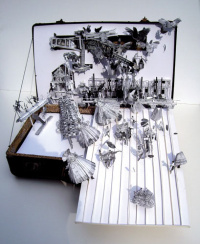Perfect fit
Designers are finding novel uses for modelling technologies, including a service that makes made-to-measure boots for professional footballers, says Scott Billings
While people may not come from moulds and templates, the products we use normally do. Take footwear: breaking in a new pair of shoes can be painful, requiring your feet to physically re-form the shoes to your own wearable shape. The shoes are not designed for your feet, but for a generic foot of roughly the same size.
This may be starting to change, thanks to rapid manufacturing techniques. One of the most immediately appealing aspects of rapid manufacturing is that it can create bespoke products, precisely tailored to the needs of a single user. This is a far cry from the mass production of goods like trainers or football boots. Operating at huge volumes, mass production ensures products are readily available for vast numbers of consumers, often at very low prices, but it’s also unavoidably impersonal.
Now, a UK performance footwear company called Prior 2 Lever is offering a service to create fully bespoke boots and trainers for individual clients, formed exactly from a biomechanical evaluation of their body and running style. The technology used? Rapid prototyping.
‘We’ve always wanted to do bespoke boots, but the cost of injection moulding was prohibitive,’ says Prior 2 Lever creative director Greg Lever-O’Keefe. ‘So we looked at rapid prototyping and got grants for research and development. We then gradually got the price points down, and based the process on a 100 per cent bespoke fit.’
To create a football boot, each foot is scanned to produce a digital model. After this, podiatrist and company co-founder Trevor Prior analyses a range of biomechanical data from the athlete using a ‘pedar’ – a device that records the distribution and magnitude of forces acting on the feet while running. This is combined with Prior’s analysis of the athlete’s running style, podiatry, flexibility, the effects of stud configuration and so on. And from all of this information a template outsole is constructed, with the bespoke orthotics already built in.
Prior 2 Lever’s bespoke boots are made possible largely thanks to a rapid manufacturing process called selective laser sintering, which builds up materials in layers, fractions of a millimetre thick. SLS does not require the specially created moulds or tooling equipment used in traditional model-making, which makes one-off or low-volume production runs more economical. It is like printing, but in three dimensions.
According to company director and rapid prototyping specialist Volker Junior, a pair of outsoles for boots or trainers can be ‘printed’ overnight. A pair of boots can be completed in two to three weeks following the collection of the biomechanical data, which itself takes about half a day. The outsole is formed from a polyamide nylon plastic, and the SLS process can create variations in thickness, density and strength at different points in the sole, according to the user’s particular needs. From there, finishes, materials and veneer can all be adjusted to suit the client’s aesthetic preferences.
‘With rapid prototyping we don’t have to produce mock-ups, and instead of taking four to eight weeks to produce a moulding, it takes a day [to produce a finished outsole]. Although the technology makes this possible, there are still barriers to entry. You need specialists like Junior and Prior, and there are not many of them around. And working with top athletes, you also need the trust of medical staff and so on,’ explains Lever-O’Keefe.
Prior 2 Lever works on an individual basis through private commissions and Lever-O’Keefe is reluctant to name specific clients. However, the company has created a number of boots for Premiership footballers, sprinters and other wealthy individuals. These high-end, performance-related products focus the bespoke design capabilities of rapid manufacturing on a pretty exclusive and affluent audience, but the company also talks about taking the process to the high street. If this happens, stores will be able to scan a customer’s feet and print a pair of perfectly fitted shoes in a matter of hours.
But why stop there? How about bespoke glasses, hearing aids, jewellery, chairs, cutlery, binoculars, headphones, bicycle seats? The list is probably as long as the number of ill-fitting things in the world. But as rapid manufacturing costs fall and machine accuracy increases, perhaps sore, squashed feet – and other similar gripes – will become a thing of the past.
-
Post a comment




